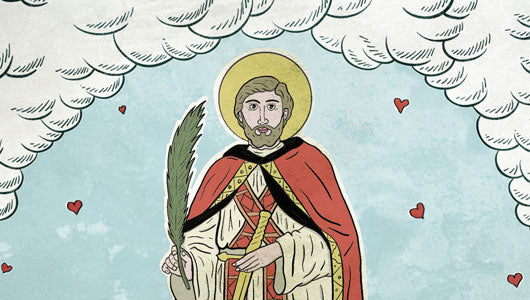
History of St. Valentine
Valentine's Day conjures images of hearts, flowers, and passionate romance. But what is Valentine's Day, and what's the real story behind it?
A peek back in time reveals that the history of Valentine's Day wasn't all sunshine and roses. Join us as we discover the truth about Valentine's Day, and dig into the dark but undeniably romantic past of its patron saint.
Who Was St. Valentine?
Valentine's Day history is steeped in legend and conflicting accounts. At least three saints named Valentine are mentioned in chronicles of early Roman martyrs killed on February 14th. One lived in the Roman province in Africa, one was a Bishop in modern-day Terni, Italy, and the last a priest in Rome.
Legend has it that one of these men crossed Claudius the Cruel, an iron-fisted Roman emperor who was involved in many violent battles during his reign. To make sure he had a steady supply of soldiers, Claudius banned engagements and marriage so young men would be more likely to sign up.
Valentine, however, believed in the power of love and the right to marry. He refused to follow the emperor's decree, and continued to perform secret marriages for the men and women of Rome. When Valentine's defiance was discovered, Claudius arrested him and brought him in front of the Prefect of Rome, a type of ancient Roman judge.
The Prefect's sentence was swift and merciless. He ordered Valentine to be beaten to death with clubs for daring to interfere with Claudius's army. The date of execution was scheduled for February 14th, 270 A.D.
The First Valentine
While Valentine was in prison awaiting execution, he was befriended by his jailer's daughter — or so the story goes. When the day of his execution arrived, he wrote her a farewell note thanking her for her kindness. He signed it, "from your Valentine," making it officially the very first Valentine, and perhaps the most tragic.
By the Middle Ages, Valentines were written and illustrated by hand, often with images of birds, who were believed to select a lifelong mate around mid-February. Mass produced Valentine's cards followed with the advent of the Industrial Revolution, and are now sold by the millions every year.
Is Valentine's Day A Festival?
In AD 496, Pope Gelasius declared February 14 the day to celebrate the life of St. Valentine of Rome. Also called the Feast of St. Valentine, the holiday is considered a Christian Feast Day, as well as a feast day in Anglican communion and the Lutheran church.
Some wonder if the origin of Valentine's Day has its roots in a pagan celebration called Lupercalia, a rowdy festival that involved animal sacrifices, general nudity, and pairing off with random townsfolk after choosing names from jars. Lupercalia was at least in part a fertility festival, as women believed the holiday would help them get pregnant and bear healthy children.
There's little hard evidence that the debauchery of Lupercalia spawned Valentine's Day, a decidedly more gentle event focused on love and romance. How did Valentine's Day become a romantic holiday? It was actually a gradual evolution that took place over centuries. The concept of courtly love became popular in the 13th and 14th century, and eventually these notions of idealized love and valor became associated with the patron saint of engagement and marriage.
Did You Know? In addition to being the patron saint of engaged couples and happy marriages, St. Valentine is the patron saint of beekeepers, the plague, traveling, epilepsy, and fainting.
Why Do We Celebrate Valentine's Day?
Some version of Valentine's Day is celebrated in countless countries around the world. What began as a religious observance has, over the years, become a way to celebrate important bonds of all kinds. While in the Middle Ages Valentine's Day was a celebration of courtly love, today it is a time to recognize family, friends, and colleagues in addition to romantic partners.
Valentine's Day is also big business. The holiday is used by governments and corporations to promote commerce, certain products, or national unity. In Ghana, for instance, Valentine's Day has been dubbed National Chocolate Day to help promote the cocoa industry.
Many global companies produce Valentine's Day products, which have become an important part of the world economy. Americans alone spend over $8 billion on Valentine's Day gifts, including cards, jewelry, candy, and flowers.
The Spiritual Meaning of Valentine's Day
The spiritual aspect of Valentine's Day may have faded over time, but can still be found in the history of the holiday. St. Valentine was honored as a Christian martyr at a time when Christians were persecuted, tortured, and forced to engage in battles with gladiators and animals in the Roman Coliseum.
In Italy and other primarily Catholic countries, there are a number of churches dedicated to St. Valentine. He is also the subject of dozens of pieces of religious art and shrines. Valentine's skull can be seen in the Basilica of Santa Maria in Cosmedin, Rome, while other parts of his skeleton are on display in such countries as Scotland, France, and the Czech Republic.
The Alternate Histories of St. Valentine
Much of St. Valentine's identity and history are still up for debate centuries later. Here are some of the most popular (and potentially true!) legends about the patron saint of love and marriage.
- He was arrested and put in prison for marrying and otherwise helping Christians, a persecuted group at the time. Though Claudius found him likeable, he did not take kindly to Valentine's attempts to convert him to Christianity, and sentenced him to death. Stones and clubs weren't enough to kill him, and he was finally beheaded.
- When Valentine performed weddings against the emperor's orders, he would give each couple a heart cut from parchment as a symbol of their vows. Thus began the tradition of lovers exchanging hearts to celebrate their love and commitment.
- The Legenda Aurea, written in 1260, was a compilation of information about each of the Christian saints. One of the most popular books of the Middle Ages, the Legenda Aurea states that St. Valentine was sentenced to death for refusing to renounce Jesus Christ, and that he restored the hearing and sight to his jailer's daughter before his execution.
- Was St. Valentine executed on February 14th? Some accounts of his life state that his sentencing took place on that date and his execution on another, but one thing is clear: February 14th is the most common date to celebrate his life and legacy.
